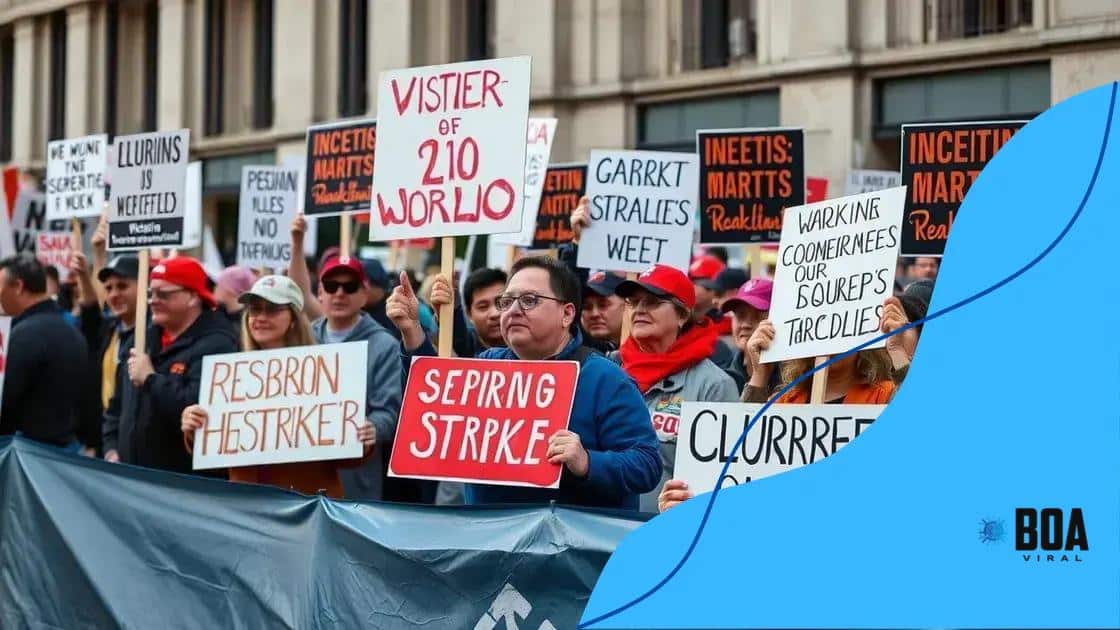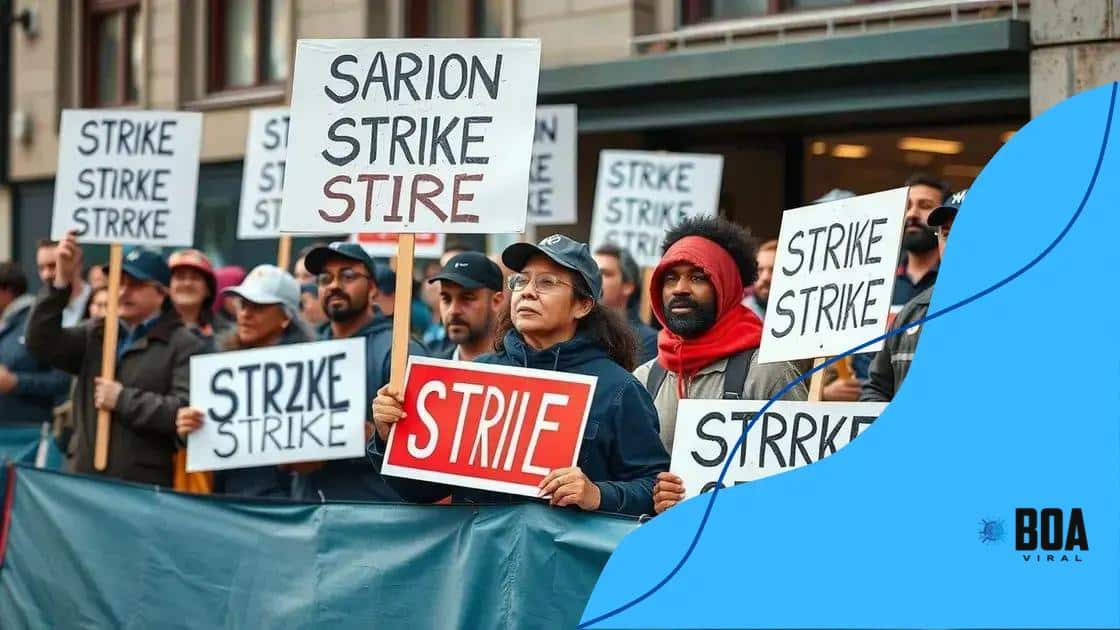Labor union collective bargaining strikes explained

Labor union collective bargaining strikes are critical actions taken by workers to demand fair wages, improved working conditions, and enhanced safety measures, highlighting their power and solidarity in advocating for their rights.
Labor union collective bargaining strikes play a significant role in shaping labor relations today. Have you considered how these actions influence workplace dynamics and employee rights? Let’s dive into their importance.
Understanding labor union collective bargaining
Understanding labor union collective bargaining is essential for grasping how workers can negotiate better conditions. This process involves unions representing employees in discussions with employers to agree on salaries, working hours, and other workplace issues. Often, these negotiations seek to ensure fair treatment and safety on the job.
During collective bargaining, union representatives and employers discuss terms that aim to benefit both parties. This collaboration can lead to improved employee satisfaction and productivity. It is crucial to recognize that effective bargaining requires clear communication and compromise.
Key Elements of Collective Bargaining
Several elements play a vital role in collective bargaining. Understanding these elements helps in appreciating the overall process:
- Negotiation Process: Both sides present their demands and proposals.
- Mediation: Sometimes, a neutral third party helps if negotiations stall.
- Contract Ratification: Union members vote to accept or reject the final agreement.
The outcomes of collective bargaining can significantly affect workplaces. Higher wages, better health benefits, and improved working conditions often result from successful negotiations. Moreover, collective agreements usually protect employees against unfair treatment.
At its core, collective bargaining represents a pivotal mechanism for ensuring that workers’ rights are upheld. By coming together, employees can leverage their collective power to achieve a more equitable environment. Such unity is particularly valuable in industries where employee voices may otherwise go unheard.
Benefits of Effective Bargaining
Effective bargaining brings several benefits to both employees and employers:
- Increased Job Satisfaction: Workers feel valued and respected.
- Reduced Turnover Rates: Happy employees are more likely to stay.
- Improved Workplace Safety: With clear guidelines, safety standards can be emphasized.
In summary, labor union collective bargaining is more than just negotiation; it is a crucial process for advancing worker rights and improving overall conditions. A strong union ensures that the voices of workers are heard, leading to a fairer and more balanced workplace.
Key strategies in collective bargaining negotiations
Key strategies in collective bargaining negotiations can significantly affect the outcome for both unions and employers. Knowing these strategies helps in preparing for discussions that can lead to better agreements.
One fundamental strategy is to establish clear objectives. Unions should know what they want to achieve, such as improved wages or enhanced safety regulations. Having specific goals helps guide the conversation and keeps negotiations focused.
Effective Communication
Effective communication is also crucial in these negotiations. Both parties must listen actively and respond thoughtfully. When unions express their demands clearly, it fosters understanding and facilitates compromise.
- Active Listening: Make sure that both sides feel heard.
- Clarifying Questions: Ask questions to ensure full understanding.
- Non-Confrontational Language: Use a positive tone to maintain a collaborative atmosphere.
Building relationships is another essential strategy. When both sides have a respectful rapport, it can lead to smoother discussions. Trust allows both parties to negotiate more openly, which can result in more lasting agreements.
Research and Preparation
Successful collective bargaining requires extensive research and preparation. Unions should gather data on industry standards and recent negotiation trends. This information empowers them during bargaining sessions.
- Market Comparisons: Compare what similar organizations provide.
- Understanding Employer Constraints: Know the financial and operational limits of the employer.
- Legal Framework: Be aware of relevant labor laws that may influence negotiations.
Lastly, patience and persistence are key. Negotiations can be lengthy and may require several meetings. Staying focused on goals while being flexible can eventually lead to a favorable agreement. Understanding that compromise is often necessary will help each party navigate this essential process effectively.
The role of strikes in labor disputes

The role of strikes in labor disputes is crucial for understanding how workers advocate for their rights. Strikes often occur when negotiations break down, and employees feel their voices are not heard. By walking off the job, workers signal their dissatisfaction and push for better conditions.
Strikes can take various forms, including full strikes, partial strikes, or wildcat strikes. Each type serves different purposes and reflects the urgency of the workers’ demands. For example, a full strike means that all employees stop working, whereas a partial strike might involve only certain groups.
Strategies Behind Strikes
When unions decide to strike, they often have specific strategies in mind. One key aspect is to mobilize public support. Unions use media campaigns to inform the public about their struggles. When communities understand the issues at stake, they are more likely to back the workers.
- Raising Awareness: Educating the public helps gain sympathy and support.
- Solidarity Events: Organizing rallies can amplify the workers’ message.
- Leveraging Social Media: Utilizing platforms to spread information rapidly is common.
Another important strategy during strikes is the negotiation of terms under pressure. Employers often feel the impact of a strike on productivity and profit. Consequently, they may be more willing to return to the bargaining table to reach an agreement.
Impact on Labor Relations
Strikes not only affect the immediate parties involved but can also influence broader labor relations. Successful strikes can lead to improved contracts, but they can also have long-term implications for labor relations in an industry. Employers may become more cautious about how they treat workers, recognizing that strong employee actions can disrupt business.
Overall, the role of strikes in labor disputes is significant as they serve as a tool for workers to assert their rights. They highlight the power dynamics between employees and employers, making it clear that workers stand united in their quest for fairness and respect.
Impact of collective bargaining strikes on workers
The impact of collective bargaining strikes on workers is significant and multifaceted. When workers strike, they aim to pressure employers to meet their demands. These actions can lead to meaningful changes in the workplace.
Strikes often result in improvements in wages, benefits, and working conditions. For instance, after a successful strike, workers may receive pay raises or enhanced healthcare benefits. Such changes can boost employee morale, leading to a more motivated workforce.
Short-term Effects
In the short term, strikes can create financial strain for workers. While they fight for better conditions, many do not receive a paycheck during the strike period. This can lead to hardships for workers and their families.
- Loss of Income: Workers may struggle to pay bills while on strike.
- Increased Solidarity: Facing challenges together can strengthen worker bonds.
- Community Support: Striking workers often gain local support, helping to mitigate financial problems.
Moreover, strikes can draw public attention to labor issues, potentially gaining support from wider communities and organizations. This kind of solidarity can strengthen the bargaining position of workers in future negotiations.
Long-term Changes
In the long run, successful strikes can reshape labor relations. Improved contracts can become a standard, leading to improved working conditions across entire industries. Employers may recognize the importance of negotiating fairly to avoid future disruptions.
Additionally, collective bargaining strikes often empower workers. They can lead to heightened awareness of labor rights and encourage more employees to stand up for their perceived injustices.
Ultimately, the impact of collective bargaining strikes is profound. They can result in better conditions, increased worker empowerment, and a greater sense of unity among employees, significantly influencing the labor landscape.
Recent trends in labor union strikes
Recent trends in labor union strikes reveal a growing movement among workers to advocate for better conditions. As economic factors fluctuate, more employees are seeking to voice their concerns and demands through strikes.
One notable trend is the rise in strikes across various industries, from education to healthcare. Workers are increasingly willing to stand up for fair wages and safe working conditions. This shift suggests a cultural change where employees believe their collective actions can lead to positive outcomes.
Increased Worker Participation
Another trend is the heightened participation of younger workers in union activities. Many of these new members are passionate about social justice and workplace equity. Their engagement brings fresh energy and ideas to traditional labor movements.
- Using Social Media: Workers are utilizing platforms for organizing and sharing their stories.
- Focus on Equity: There is a strong emphasis on diversity and inclusion within labor movements.
- Grassroots Organizing: Employees are taking the initiative to form or strengthen unions at the local level.
Moreover, the COVID-19 pandemic has accelerated some of these trends. Workers have become more aware of their rights and the importance of having a collective voice. The demand for safer working environments has led to a number of strikes aimed at addressing health and safety protocols.
Solidarity Beyond Borders
International solidarity is emerging as another trend. Unions are collaborating across borders to support each other’s causes. This global perspective strengthens the labor movement and promotes shared goals among workers worldwide.
As labor unions adapt to new challenges, they continue to play a critical role in advocating for workers. The fight for better working conditions and fair representation is more relevant than ever. These recent trends indicate a robust and evolving labor movement that seeks to empower employees across various sectors.
FAQ – Frequently Asked Questions About Labor Union Strikes
What are the main reasons workers go on strike?
Workers typically strike to demand better wages, improved working conditions, and increased safety measures in the workplace.
How do strikes affect employers?
Strikes can disrupt operations and lead to financial losses, prompting employers to return to negotiations to resolve issues.
What role do unions play in strikes?
Unions organize strikes, representing workers’ interests and helping to negotiate better terms with employers.
How has the COVID-19 pandemic influenced labor strikes?
The pandemic has heightened awareness of workers’ rights, resulting in more strikes focused on health and safety conditions.






